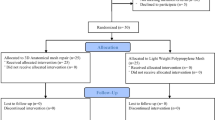Abstract
Background
Adverse economic conditions often prevent the widespread implementation of modern surgical techniques in third world countries such as in Sub-Sahara Africa.
Aim of the study
To demonstrate that a modern technique (laparoscopic totally extraperitoneal inguinal hernioplasty [TEP]) can safely be performed at significantly lower cost using inexpensive mesh material.
Settings
Douala University Hospital Gynecology, Obstetrics and Pediatrics and two affiliated centers, Ayos Regional Hospital and Edéa Regional Hospital in Cameroon.
Patients and methods
Prospective randomized controlled trial (RCT) of consecutive adult patients presenting with primary inguinal hernia treated by TEP, comparing implantation of sterilized mosquito mesh (MM) with conventional polypropylene mesh (CM). Primary endpoints were peroperative, early and midterm postoperative complications and hernia recurrence at 30 months.
Results
Sixty-two patients (48 males) were randomized to MM (n = 32) or CM (n = 30). Groups were similar in age distribution and occupational features. Peroperative and early outcomes differed in terms of conversion rate (2/32 MM) due to external (electrical power supply) factors and mesh removal for early obstruction (1/30 CM). No outcome differences, including no recurrences, were noted after a median follow-up of 21 months.
Conclusion
In this RCT with medium-term follow-up, TEP performed with MM appears not inferior to CM.


Similar content being viewed by others
References
Tongaonkar RR, Reddy BV, Mehta VK, Singh NS, Shivade S (2003) Preliminary multicentric trial of cheap indigenous mosquito-net cloth for tension-free hernia repair. Ind J Surg 65(1):89–95
Löfgren J, Nordin P, Ibingira C, Matovu A, Galiwango M, Wladis A (2016) A randomized trial of low-cost mesh in groin hernia repair. N Engl J Med 374:146–153
Bittner R, Arregui M, Bisgaard T et al (2011) Guidelines for laparoscopic (TAPP) and endoscopic (TEP) treatment of inguinal Hernia [International Endohernia Society (IEHS)]. Surg Endosc 25(9):2773–2843
Essola et al (2021) The socio-economic aspects of laparoscopic approach in the treatment of inguinal hernia by mesh in Cameroon. J Surg Res 4(1):158–166
Agrawal M, Bhagwat S, Rao P (2020) Dulucq’s technique for laparoscopic totally extraperitoneal hernioplasty. J Minim Access Surg 16(1):94–96
Leubner KD, Chop WM Jr, Ewigman B, Loven B, Park MK (2007) Clinical inquiries. What is the risk of bowel strangulation in an adult with an untreated inguinal hernia. J Fam Pract 56(12):1039–1041
Naveen N, Srinath R (2014) A comparative study between modified bassini’s repair and lichtenstein mesh repair (LMR) of inguinal hernias in rural population. J Clin Diagn Res 8(2):88–91
Bullen NL, Massey LH, Antoniou SA, Smart NJ, Fortelny RH (2019) Open versus laparoscopic mesh repair of primary unilateral uncomplicated inguinal hernia: a systematic review with meta-analysis and trial sequential analysis. Hernia 23(3):461–472
http://iloglobalprogramme.Social-protection.org. Accessed 26 July 2020
Löfgren J, Beard J, Ashley T (2018) Groin hernia surgery in low-resource settings—a problem still unsolved. N Engl J Med 378(14):1357–1358
Mitura S, Koziel S (2018) The influence of different sterilization types on mosquito net mesh characteristics in groin hernia repair. Hernia 22(3):483–490
Sanders D, Kingsnorth A, Moate R, Staer J (2013) An in vitro study assessing the infection risk of low-cost polyethylene mosquito net compared with commercial hernia prosthetics. Surg Res 183(2):e31–e37
Wiessner R, Kleber T, Ekwelle N, Ludwig K, Richter D-U (2017) In-vitro examination of the biocompatibility of fibroblast cell lines on alloplastic meshes and sterilized polyester mosquito mesh. Hernia 21(3):407–416
Ahmad MH, Pathak S, Clement KD, Aly EH (2019) Meta-analysis of the use of sterilized mosquito net mesh for inguinal hernia repair in less economically developed countries. BJS Open 3(4):429–435
Patterson T, Currie P, Patterson S, Patterson P, Meek C, McMaster R (2017) A systematic review and meta-analysis of the post-operative adverse effects associated with mosquito net mesh in comparison to commercial hernia mesh for inguinal hernia repair in low income countries. Hernia 21(3):397–405
Fiennes M, Himpens J (1997) The totally extraperitoneal laparoscopy hernia repair. Surg Endosc 11:696
Barac C, Voreux JP, Occelli G, Catheline JM, Champault G (1999) Influence de la formation chirurgicale et de l’apprentissage sur les résultats du traitement laparoscopique des hernies de l’aine. Chirurgie 124:298–303
Koeckerling F (2019) TEP for elective primary unilateral inguinal hernia repair in men: what do we know? Hernia 23(3):439–459
Gavriilidis P, Davies R, Wheeler J, de Angelis N, di Saverio S (2019) Total extraperitoneal endoscopic hernioplasty (TEP) versus Lichtenstein hernioplasty: a systematic review by updated traditional and cumulative meta-analysis of randomised-controlled trials. Hernia 23(6):1093–1103
Stephenson BM, Kingsnorth AN (2011) Inguinal hernioplasty using mosquito net mesh in low income countries: an alternative and cost effective prosthesis. BMJ 343:d7448
Yang J, Papandria D, Rhee D, Perry H, Abdullah F (2011) Low-cost mesh for inguinal hernia repair in resource-limited settings. Hernia 15(5):485–489
Funding
The Project was funded by Accadémie de Recherche de l’Enseignement Supérieur (ARES) Belgium, ARES-PFS2016-Cameroon grant to J. S.
Author information
Authors and Affiliations
Corresponding author
Ethics declarations
Disclosures
The authors: Dr Essola Basile, Professor Himpens Jacques, Dr Engbang Ndamba Jean Paul, Dr. Limgba Augustin,Dr. Djomo Tamchom Dominique, Dr. Landenne Jacques, Dr.Ngaroua Esdras, Professor Hermans P. Michel,, Mboudou Emile Telesphore, Dr. Lingier Pierre, Professor Souopgui Jacob, Professor Loi Patrizia declare no conflict of interest in relation to the content of this manuscript.
Ethical approval
The study was performed in accordance with the principles of the Declaration of Helsinki. All patients provided written informed consent. IRB approval was obtained from the ministry of health under the reference 2018/0042/HGOPED/DG/CEI. Reference of study registration: ISRCTN24826334.The study was conducted according to CONSORT guidelines and Checklist (Schulze et al., 2010).
Additional information
Publisher's Note
Springer Nature remains neutral with regard to jurisdictional claims in published maps and institutional affiliations.
Appendix
Appendix

Rights and permissions
About this article
Cite this article
Essola, B., Himpens, J., Ndamba, J.E. et al. Prospective, randomized clinical trial of laparoscopic totally extraperitoneal inguinal hernia repair using conventional versus custom-made (mosquito) mesh performed in Cameroon: a short-term outcomes. Surg Endosc 36, 6558–6566 (2022). https://doi.org/10.1007/s00464-022-09046-8
Received:
Accepted:
Published:
Issue Date:
DOI: https://doi.org/10.1007/s00464-022-09046-8




